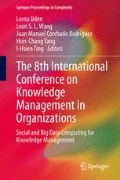Abstract
This paper presents and describes the construction of a recommender system model that classifies input information to yield product recommendations. This model was applied within the contents industry [1] by using artificial neural networks (particularly adaptive resonance theory) as an intelligent agent. The Netflix Prize data base was used and the model’s validation and simulation was written using Matlab®.
Access this chapter
Tax calculation will be finalised at checkout
Purchases are for personal use only
References
Schafer J, Frankowski D, Herlocker J, Sen S (2007) Collaborative filtering recommender systems the adaptive web. In: Brusilovsky P, Kobsa A, Nejdl W (eds) In the Adaptive Web, vol 4321. Springer, Berlin, pp 291–324
Carpenter GA, Grossberg S (1989) Search mechanisms for adaptive resonance theory (ART) architectures. In: Proceedings of International Conference on Neural Networks, Washington, DC, USA, pp 201–205
Caudell TP, Healy MJ (1994) Adaptive resonance theory networks in the Encephalon autonomous vision system, Neural Networks. IEEE World Congress on Computational Intelligence, vol 2, pp 1235–1240
Heins LG, Tauritz DR, June M (1995) Adaptive Resonance Theory (ART): an introduction, internal report 95–35, Department of Computer Science, Leiden University
Chen M, Ghorbani AA, Bhavsar VC (2005) Incremental communication for adaptive resonance theory networks. IEEE Trans Neural Networks 16(1):132–144
Buder J, Schwind C (2012) Learning with personalized recommender systems: a psychological view. Comput Hum Behav 28(1):207–216
Israel Gonzalez-Carrasco, Erick Ulisses Monfil-Contreras, Giner Alor-Hernández, Guillermo Cortes-Robles, Alejandro Rodriguez-Gonzalez (2013) A recommendation system generator using domain-based heuristics. Expert Syst Appl 40(1):242–256
Bobadilla J, Hernando A, Ortega F, Bernal J (2011) A framework for collaborative filtering recommender systems. Expert Syst Appl 38(12):14609–14623
Adomavicius G, Tuzhilin A (2008) Context-aware recommender systems. In: Proceedings of the 2008 ACM conference on recommender systems, New York University, New York, USA, pp 335–336
Tang X, Zeng Q (2012) Keyword clustering for user interest profiling refinement within paper recommender systems. J Syst Softw 85(1):87–101
González R, Martinez OS, Cueva J, Garcia-Bustelo BC, Gayo JEL, Ordoñez P (2011) Recommendation system based on user interaction data applied to intelligent electronic books. Comput Hum Behav 27(4):1445–1449
Wang P (1998) Why recommendation is special? In: Papers from the 1998 workshop on recommender systems, part of the 15th National Conference on Artificial Intelligence (AAAI 1998), Madison, Wisconsin, EUA, pp 111–113
Glotin H, Warnier P, Dandurand F, Dufau S, Lété B, Touzet C, Ziegler JC, Grainger J (2010) An adaptive resonance theory account of the implicit learning of orthographic word forms. J Physiol Paris 104(1–2):19–26
Bennett J, Lanning S (2007) The Netflix prize http://www.netflixprize.com/. Accessed 20 Aug 2013
Hilera González JR (2000) Redes neuronales artificiales: fundamentos, modelos y aplicaciones. Alfaomega, México
Author information
Authors and Affiliations
Corresponding author
Editor information
Editors and Affiliations
Rights and permissions
Copyright information
© 2014 Springer Science+Business Media Dordrecht
About this paper
Cite this paper
Bermudez, G.M.T., Espada, J.P., Nuñez-Valdez, E.R. (2014). An Application for Recommender Systems in the Contents Industry. In: Uden, L., Wang, L., Corchado Rodríguez, J., Yang, HC., Ting, IH. (eds) The 8th International Conference on Knowledge Management in Organizations. Springer Proceedings in Complexity. Springer, Dordrecht. https://doi.org/10.1007/978-94-007-7287-8_26
Download citation
DOI: https://doi.org/10.1007/978-94-007-7287-8_26
Published:
Publisher Name: Springer, Dordrecht
Print ISBN: 978-94-007-7286-1
Online ISBN: 978-94-007-7287-8
eBook Packages: Computer ScienceComputer Science (R0)

